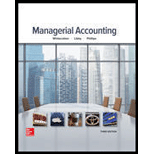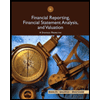
Managerial Accounting
3rd Edition
ISBN: 9780077826482
Author: Stacey M Whitecotton Associate Professor, Robert Libby, Fred Phillips Associate Professor
Publisher: McGraw-Hill Education
expand_more
expand_more
format_list_bulleted
Question
Chapter 10, Problem 15Q
To determine
Concept introduction:
All companies sometimes make investment in short-run for financial improvement which sometimes could be the reason for the detrimental effect in the long-run period of the business.
The example of short-run investment for financial improvement that could be detrimental for long-run period.
Expert Solution & Answer
Want to see the full answer?
Check out a sample textbook solution
Students have asked these similar questions
Step by step.....?
Please help!!!! I need it bad
A company sells a product for $25 per unit. The variable cost per unit is $15, and the total fixed costs are $50,000.
a) How many units must the company sell to break even?
b) If the company wants a profit of $10,000, how many units must it sell?
Chapter 10 Solutions
Managerial Accounting
Ch. 10 - Explain how centralized and decentralized...Ch. 10 - Why does decentralization create the need for...Ch. 10 - What is the controllability principle and why is...Ch. 10 - Prob. 4QCh. 10 - Prob. 5QCh. 10 - Prob. 6QCh. 10 - Prob. 7QCh. 10 - Prob. 8QCh. 10 - Return on investment may be separated into two...Ch. 10 - Prob. 10Q
Ch. 10 - Prob. 11QCh. 10 - Prob. 12QCh. 10 - Prob. 13QCh. 10 - Prob. 14QCh. 10 - Prob. 15QCh. 10 - Prob. 16QCh. 10 - Prob. 17QCh. 10 - Why must a company consider its incentive and...Ch. 10 - Prob. 19QCh. 10 - Prob. 20QCh. 10 - Prob. 21QCh. 10 - Prob. 22QCh. 10 - Prob. 23QCh. 10 - Prob. 24QCh. 10 - Prob. 25QCh. 10 - What are negotiated transfer prices? Explain two...Ch. 10 - Sally Thorne is a profit center manager for ABC...Ch. 10 - Prob. 2MCCh. 10 - Which of the following statements is true? a. A...Ch. 10 - Prob. 4MCCh. 10 - Prob. 5MCCh. 10 - Prob. 6MCCh. 10 - Prob. 7MCCh. 10 - Prob. 8MCCh. 10 - Which of the following is not a component of the...Ch. 10 - Prob. 10MCCh. 10 - Using Terms to Complete Sentences about...Ch. 10 - Prob. 2MECh. 10 - Prob. 3MECh. 10 - Applying Balanced Scorecard to Real World Company...Ch. 10 - Applying Balanced Scorecard to Online Company...Ch. 10 - Prob. 6MECh. 10 - Prob. 7MECh. 10 - Prob. 8MECh. 10 - Prob. 9MECh. 10 - Prob. 10MECh. 10 - Prob. 11MECh. 10 - Prob. 12MECh. 10 - Prob. 13MECh. 10 - Prob. 2ECh. 10 - Prob. 3ECh. 10 - Prob. 4ECh. 10 - Calculating Return on Investment, Residual Income,...Ch. 10 - Prob. 6ECh. 10 - Evaluating Managerial Performance Using Return on...Ch. 10 - Evaluating Managerial Performance Using Return on...Ch. 10 - Prob. 9ECh. 10 - Determining the Impact of Various Transactions on...Ch. 10 - Determining Different Types of Responsibility...Ch. 10 - Prob. 14ECh. 10 - Prob. 15ECh. 10 - Prob. 16ECh. 10 - Matching Measures of Performance with the Correct...Ch. 10 - Determining Minimum, Maximum, Negotiated Transfer...Ch. 10 - Prob. 19ECh. 10 - Prob. 20ECh. 10 - Calculating Return on Investment, Residual Income,...Ch. 10 - Prob. 1.2GAPCh. 10 - Calculating Unknowns, Predicting Relationship...Ch. 10 - Calculating Unknowns, Predicting Relationship...Ch. 10 - Prob. 2.3GAPCh. 10 - Prob. 2.4GAPCh. 10 - Prob. 2.5GAPCh. 10 - Prob. 2.6GAPCh. 10 - Prob. 3.1GAPCh. 10 - Prob. 3.2GAPCh. 10 - Prob. 3.3GAPCh. 10 - Prob. 3.4GAPCh. 10 - Prob. 3.5GAPCh. 10 - Prob. 3.6GAPCh. 10 - Prob. 4.1GAPCh. 10 - Prob. 4.2GAPCh. 10 - Prob. 4.3GAPCh. 10 - Prob. 4.4GAPCh. 10 - Prob. 4.5GAPCh. 10 - Prob. 5.1GAPCh. 10 - Prob. 5.2GAPCh. 10 - Prob. 5.3GAPCh. 10 - Prob. 5.4GAPCh. 10 - Prob. 6GAPCh. 10 - Prob. 1.1GBPCh. 10 - Prob. 1.2GBPCh. 10 - Prob. 2.1GBPCh. 10 - Prob. 2.2GBPCh. 10 - Prob. 2.3GBPCh. 10 - Prob. 2.4GBPCh. 10 - Prob. 2.5GBPCh. 10 - Prob. 2.6GBPCh. 10 - Prob. 3.1GBPCh. 10 - Prob. 3.2GBPCh. 10 - Prob. 3.3GBPCh. 10 - Prob. 3.4GBPCh. 10 - Prob. 3.5GBPCh. 10 - Prob. 3.6GBPCh. 10 - Prob. 4.1GBPCh. 10 - Prob. 4.2GBPCh. 10 - Prob. 4.3GBPCh. 10 - Prob. 4.4GBPCh. 10 - Prob. 4.5GBPCh. 10 - Prob. 5.1GBPCh. 10 - Prob. 5.2GBPCh. 10 - Prob. 5.3GBPCh. 10 - Prob. 5.4GBPCh. 10 - Prob. 6GBP
Knowledge Booster
Similar questions
- Don't use ai. A company has the following data: Cash: $50,000Accounts Receivable: $30,000Inventory: $60,000Current Liabilities: $70,000a) What is the company’s acid-test ratio?b) Is the company in a strong liquidity position based on this ratio?arrow_forwardQuestion 5:A company has the following data: Cash: $50,000Accounts Receivable: $30,000Inventory: $60,000Current Liabilities: $70,000a) What is the company’s acid-test ratio?b) Is the company in a strong liquidity position based on this ratio?arrow_forwardQuestion 5: Acid-Test RatioA company has the following data: Cash: $50,000Accounts Receivable: $30,000Inventory: $60,000Current Liabilities: $70,000a) What is the company’s acid-test ratio?b) Is the company in a strong liquidity position based on this ratio?arrow_forward
- Question 4: Depreciation (Straight-Line Method)A company purchases machinery for $50,000. The estimated salvage value is $5,000, and the useful life is 10 years. a) Calculate the annual depreciation expense.b) What will the book value of the machinery be after 4 years?arrow_forwardInventory Valuation (FIFO Method)A company had the following inventory transactions during the month: Beginning inventory: 100 units @ $10 eachPurchase: 200 units @ $12 eachPurchase: 150 units @ $13 eachAt the end of the month, 250 units remain in inventory. Calculate the value of the ending inventory using the FIFO method. explainarrow_forwardNeed assistance without use of ai.arrow_forward
- Depreciation (Straight-Line Method)A company purchases machinery for $50,000. The estimated salvage value is $5,000, and the useful life is 10 years. a) Calculate the annual depreciation expense.b) What will the book value of the machinery be after 4 years?arrow_forwardA company has the following data: Cash: $50,000Accounts Receivable: $30,000Inventory: $60,000Current Liabilities: $70,000a) What is the company’s acid-test ratio?b) Is the company in a strong liquidity position based on this ratio?arrow_forwardDon't want AI answerarrow_forward
arrow_back_ios
SEE MORE QUESTIONS
arrow_forward_ios
Recommended textbooks for you
 Intermediate Financial Management (MindTap Course...FinanceISBN:9781337395083Author:Eugene F. Brigham, Phillip R. DavesPublisher:Cengage Learning
Intermediate Financial Management (MindTap Course...FinanceISBN:9781337395083Author:Eugene F. Brigham, Phillip R. DavesPublisher:Cengage Learning Financial Reporting, Financial Statement Analysis...FinanceISBN:9781285190907Author:James M. Wahlen, Stephen P. Baginski, Mark BradshawPublisher:Cengage LearningPrinciples of Accounting Volume 2AccountingISBN:9781947172609Author:OpenStaxPublisher:OpenStax College
Financial Reporting, Financial Statement Analysis...FinanceISBN:9781285190907Author:James M. Wahlen, Stephen P. Baginski, Mark BradshawPublisher:Cengage LearningPrinciples of Accounting Volume 2AccountingISBN:9781947172609Author:OpenStaxPublisher:OpenStax College- Business/Professional Ethics Directors/Executives...AccountingISBN:9781337485913Author:BROOKSPublisher:Cengage
 Managerial AccountingAccountingISBN:9781337912020Author:Carl Warren, Ph.d. Cma William B. TaylerPublisher:South-Western College Pub
Managerial AccountingAccountingISBN:9781337912020Author:Carl Warren, Ph.d. Cma William B. TaylerPublisher:South-Western College Pub EBK CONTEMPORARY FINANCIAL MANAGEMENTFinanceISBN:9781337514835Author:MOYERPublisher:CENGAGE LEARNING - CONSIGNMENT
EBK CONTEMPORARY FINANCIAL MANAGEMENTFinanceISBN:9781337514835Author:MOYERPublisher:CENGAGE LEARNING - CONSIGNMENT

Intermediate Financial Management (MindTap Course...
Finance
ISBN:9781337395083
Author:Eugene F. Brigham, Phillip R. Daves
Publisher:Cengage Learning

Financial Reporting, Financial Statement Analysis...
Finance
ISBN:9781285190907
Author:James M. Wahlen, Stephen P. Baginski, Mark Bradshaw
Publisher:Cengage Learning

Principles of Accounting Volume 2
Accounting
ISBN:9781947172609
Author:OpenStax
Publisher:OpenStax College

Business/Professional Ethics Directors/Executives...
Accounting
ISBN:9781337485913
Author:BROOKS
Publisher:Cengage

Managerial Accounting
Accounting
ISBN:9781337912020
Author:Carl Warren, Ph.d. Cma William B. Tayler
Publisher:South-Western College Pub

EBK CONTEMPORARY FINANCIAL MANAGEMENT
Finance
ISBN:9781337514835
Author:MOYER
Publisher:CENGAGE LEARNING - CONSIGNMENT